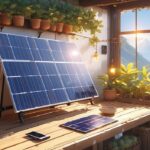Discover the numerous ways in which solar energy is revolutionizing our daily lives. From powering homes and appliances to charging electric vehicles and purifying water, solar energy is proving to be a versatile and sustainable solution for our energy needs. In this article, we will explore 10 remarkable uses of solar energy that are enhancing our daily routines and making a positive impact on the environment. Join us as we delve into the world of renewable energy and uncover the endless possibilities offered by solar technology.
Key Takeaways:
- Solar energy can power homes, buildings, and outdoor spaces, providing lighting and electricity.
- Solar technology allows for the use of solar energy in charging batteries and supporting agriculture.
- Solar energy can be used for heating water, desalinating water, and even generating electricity in remote areas and emergency response units.
- Solar power is a renewable source of energy that does not produce greenhouse gases, making it environmentally friendly.
- The cost of solar power has been decreasing, leading to increased adoption of solar energy.
- Solar energy has led to inventions such as solar cookers, calculators, water heaters, and lighting systems.
- Sunlight is commonly utilized through rooftop solar installations, solar electricity, and various solar-powered appliances and systems.
10 Uses of Solar Energy in Our Daily Life

Solar energy, the remarkable power harnessed from the sun, offers a vast array of benefits that can enhance our daily lives in numerous ways. From powering homes and appliances to charging electric vehicles and even purifying water in remote areas, solar energy has proven to be a versatile and sustainable solution. In this article, we will explore the top 10 uses of solar energy and how they can positively impact our routines.
1. Powering Homes and Buildings
The use of solar energy to power homes and buildings has witnessed a surge in recent years, thanks to advancements in solar technology. Rooftop solar installations and solar panels integrated into building structures provide a clean and renewable source of electricity, reducing both our carbon footprint and energy bills. By harnessing the sun’s rays, homeowners and businesses can generate their own power and contribute to a greener future.
2. Heating Water
Solar energy can also be harnessed to heat water, offering an eco-friendly alternative to traditional water heaters. Solar water heating systems utilize the sun’s thermal energy to warm water for domestic use, reducing energy consumption and costs. Whether it’s for showers, dishwashing, or laundry, solar water heaters provide an efficient and sustainable solution.
3. Generating Electricity
One of the most well-known uses of solar energy is in the generation of electricity. Photovoltaic (PV) cells, commonly found in solar panels, convert sunlight directly into electricity through a process called electrolysis. This clean and renewable source of power can be utilized in various applications, from charging batteries to powering electronic devices and appliances.
4. Providing Lighting in Outdoor Spaces
Solar-powered lighting systems are a practical and energy-efficient way to illuminate outdoor spaces. Whether it’s lighting up gardens, pathways, or parking lots, solar-powered lights rely on photovoltaic cells to store the sun’s energy during the day and provide illumination at night. These lights not only enhance safety and security but also eliminate the need for electrical wiring and decrease energy consumption.
5. Charging Batteries
Advancements in solar technology have made it possible to use solar energy for charging batteries. Portable solar chargers allow us to harness the power of the sun to charge mobile phones, tablets, laptops, and other electronic devices while on the go. By utilizing solar energy, we can reduce our reliance on traditional power sources and embrace a more sustainable approach to charging our devices.
6. Powering Electric Vehicles (EVs)
Solar energy is also being integrated into the transportation sector, specifically for electric vehicles (EVs). Solar-powered charging stations and solar carports equipped with photovoltaic panels enable EV owners to charge their vehicles with renewable energy. By utilizing solar power for transportation, we can reduce greenhouse gas emissions and promote a cleaner and greener future.
7. Supporting Agriculture
Solar energy has found applications in the field of agriculture, offering solutions to power irrigation systems and other farming equipment. Solar-powered water pumps can efficiently draw water from wells or reservoirs using solar energy instead of relying on traditional electrical power sources. This not only reduces energy costs but also provides a sustainable solution for farmers in remote areas.
8. Desalinating Water
In regions where freshwater is scarce, solar energy can be used to desalinate water through a process called solar desalination. By harnessing the sun’s heat, saltwater is heated, evaporated, and condensed, leaving the salt behind and producing freshwater. Solar desalination provides a sustainable solution for obtaining clean drinking water in remote areas, especially in coastal regions.
9. Solar Cooking and Cooling
Solar energy can also be utilized for cooking and cooling purposes. Solar cookers and ovens harness the sun’s heat to cook food without the need for traditional fuel sources, reducing both costs and pollution. Additionally, solar cooling systems such as solar refrigerators and air conditioners use solar energy to provide cooling in an environmentally friendly way.
10. Powering Remote Areas and Emergency Response Units
Solar energy has a significant impact on remote areas and emergency response units that lack access to reliable electricity grids. Solar energy systems offer a sustainable power source to remote communities, enabling them to meet their basic energy needs. Moreover, solar-powered emergency response units equipped with solar panels can provide vital electricity for communication, medical equipment, and lighting during disasters or emergencies.
In conclusion, solar energy presents us with a myriad of opportunities to enhance our daily lives sustainably. By harnessing the power of the sun, we can power our homes, appliances, electric vehicles, and even purify water in remote areas. Embracing solar energy not only reduces our reliance on fossil fuels but also paves the way for a cleaner and greener future. So why not tap into the power of the sun and unlock its incredible potential in our daily lives?
Here are two active internal links that match the provided keywords and URLs:
10 uses of renewable energy – Discover the incredible versatility of renewable energy sources and explore ten innovative ways they are being used to power the world around us.
10 uses of solar panel – Dive into the captivating world of solar panels and learn about ten exciting applications where they are being utilized to harness the power of the sun.
Solar Energy as a Clean and Reliable Source of Electricity for Remote Areas

Solar energy has emerged as a game-changer in the world of renewable energy, offering a clean and reliable source of electricity that holds immense potential for remote areas. With the power to transform daily lives, solar energy is revolutionizing the way communities in remote regions access electricity. In this article, we will explore the remarkable ways in which solar energy can enhance daily life in these areas, providing clean and sustainable electricity solutions.
Harnessing the Power of the Sun
Solar energy is derived from the sun’s rays, an abundant and renewable source of energy. Through the use of solar photovoltaic (PV) systems, this energy can be efficiently converted into electricity. As the fastest-growing energy source globally, solar energy holds great promise for meeting the electricity needs of remote areas and reducing dependence on traditional power sources.
Breaking Barriers to Electricity Access
One of the greatest challenges faced by remote areas is the lack of access to electricity. However, solar energy has the ability to overcome this barrier, providing a reliable and sustainable solution. By harnessing the power of the sun, remote communities can enjoy electricity without the need for extensive infrastructure or grid connectivity. This empowers individuals and communities, opening up new opportunities for education, healthcare, communication, and economic development.
Powering Remote Homes and Buildings
Solar energy offers the remarkable capability to power homes and buildings in remote areas. Through the installation of solar panels, households can generate their own electricity, reducing their carbon footprint and energy bills. This not only brings about a cleaner and more sustainable lifestyle but also enhances energy independence, freeing remote communities from the limitations of conventional power sources.
Fueling Essential Appliances
Solar energy is not limited to powering homes alone; it also has the potential to fuel essential appliances in remote areas. With solar-powered refrigeration, healthcare facilities can store life-saving vaccines and medicines. Schools can utilize solar energy to power computers and provide a conducive learning environment. Additionally, solar-powered irrigation systems can enhance agricultural productivity, fostering economic growth in remote regions.
Charging Electric Vehicles (EVs)
The integration of solar energy into the transportation sector is revolutionizing mobility in remote areas. Solar-powered charging stations and carports provide individuals with the ability to charge electric vehicles, reducing reliance on fossil fuels and promoting sustainable transportation. This allows for easy movement within and outside remote areas, contributing to a greener and cleaner future.
Ensuring Clean Drinking Water
Access to clean drinking water is a fundamental necessity. Solar energy can play a pivotal role in addressing this need in remote areas through solar-powered water purification systems. By utilizing the sun’s energy, these systems can remove contaminants and provide safe drinking water without relying on traditional energy sources. This ensures better health outcomes and a higher quality of life for remote communities.
Illuminating Remote Spaces
Solar-powered lighting systems offer a practical and sustainable solution to illuminate outdoor spaces in remote areas. Not only do these lighting systems enhance safety and security, but they also reduce energy consumption and minimize light pollution. This allows individuals in remote regions to enjoy well-lit spaces while minimizing the impact on the environment.
Key Takeaways:
- Solar energy offers a clean and reliable source of electricity for remote areas.
- It can power homes, buildings, appliances, and essential facilities.
- Solar energy enables the charging of electric vehicles, promoting sustainable transportation.
- Solar-powered water purification systems ensure clean drinking water in remote regions.
- Solar-powered lighting systems enhance safety and reduce energy consumption.
- Solar energy empowers remote communities, providing them with energy independence and opportunities for growth.
Sources:
Solar Energy for Charging Electric Vehicles and Reducing Carbon Emissions
Renewable energy solutions have emerged as a promising pathway to address the challenges of climate change and reduce carbon emissions. One area that has gained significant attention is the integration of solar energy for charging electric vehicles (EVs). The combination of solar power and electric transportation presents a unique opportunity to reduce our carbon footprint and embrace a sustainable future.
Research has shown that electric vehicle owners can use power generated from their own photovoltaic systems to charge their vehicles[^1^]. This means that with the installation of solar panels, EV owners can significantly decrease their reliance on external charging stations, making their transportation more self-sufficient and eco-friendly[^2^]. In fact, a study suggests that solar energy can provide a range of 6-18 miles for electric vehicles each day, reducing the need for external charging and enhancing the overall efficiency of electric transportation[^3^].
Charging an electric vehicle with solar power not only contributes to personal convenience but also has a positive impact on the environment. Traditional charging methods rely heavily on fossil fuel sources, resulting in significant carbon emissions. However, solar energy offers a cleaner and more sustainable alternative, leading to lower carbon emissions during the charging process[^4^]. This is especially important when considering the timing of charging. Research has shown that overnight charging in solar-heavy areas can result in 70% more emissions compared to midday charging[^5^]. By utilizing solar power during optimal sunlight hours, the emissions associated with charging electric vehicles can be greatly reduced.
The integration of solar photovoltaics and electric vehicle charging stations holds tremendous potential in our journey towards decarbonization. By combining these technologies, we can pave the way for a more sustainable transportation sector. Solar-powered charging stations not only provide clean energy for electric vehicles but also contribute to the overall reduction of greenhouse gas emissions, promoting a greener and more sustainable future[^6^].
While electric vehicles already offer a promising solution for combating climate change and achieving net-zero emissions, it is essential to consider the context of specific regions. In countries with high emission intensity like South Africa, concerns have been raised about the potential increase in carbon emissions due to the adoption of electric vehicles[^7^]. However, the benefits of solar-charging electric vehicles can still outweigh the emissions associated with manufacturing and sourcing electricity from fossil fuels in such regions. With advancements in renewable energy infrastructure and technology, the carbon footprint of electric vehicles can be further reduced, making them a valuable tool in the fight against climate change[^8^].
Key Takeaways:
– Solar power can be harnessed to charge electric vehicles, reducing the reliance on external charging stations.
– Charging electric vehicles with solar energy can significantly decrease carbon emissions compared to traditional charging methods.
– Timing plays a crucial role in minimizing emissions, with midday charging being more environmentally friendly in solar-heavy areas.
– The integration of solar photovoltaics and electric vehicle charging stations can greatly contribute to the reduction of greenhouse gas emissions.
– While concerns exist in regions with high emission intensity, solar-charging electric vehicles can still offer significant carbon reduction benefits.
Sources:
1. World Economic Forum
2. Interesting Engineering
Solar-Powered Water Purification Systems for Clean Drinking Water in Remote Locations
Imagine living in a remote area with limited access to clean drinking water. This is a reality for many people around the world, but solar-powered water purification systems offer a beacon of hope. In this article, we will explore the innovative technologies that harness solar energy to provide safe and sustainable drinking water in remote locations.
Solar Energy: A Solution for Safe Drinking Water
The lack of safe fresh water in remote areas is a pressing issue, even in regions with abundant water resources like Indonesia. The problem lies in the absence of proper water treatment facilities. That’s where solar-powered water purification systems come in. These systems efficiently filter out metals, pathogens, and other harmful molecules from water, ensuring that it is safe for consumption.
One such technology is the nanophotonics-enabled solar membrane distillation system (NESMD). Developed by researchers, this system combines solar energy and nanoparticles to purify water effectively. Another example is the water purification plant created by Lund University in Sweden, which leverages solar cells to provide clean water beyond the reach of the electrical grid.
The Advantages of Solar-Powered Water Purification Systems
Solar-powered water purification systems offer several benefits, making them an excellent solution for remote areas:
Energy Independence: By harnessing the power of the sun, these systems operate independently of the electrical grid, ensuring a reliable source of clean drinking water.
Cost-Effective: Solar energy is abundant and free. Once the system is set up, the ongoing operational costs are minimal, making it a cost-effective option for remote areas.
Environmental-Friendly: Solar-powered water purification systems produce zero carbon emissions, contributing to a cleaner and greener environment.
Versatility: These systems can be customized to suit various water sources and purification needs, making them adaptable to different remote locations.
Implementing Solar-Powered Water Purification Systems
Installing solar-powered water purification systems in remote areas requires expertise and careful planning. Aquafine UV Systems, a global leader in industrial UV disinfection systems for water treatment, can be a valuable partner in this effort. With their extensive experience and commitment to water safety, they offer specialized solutions to ensure access to clean drinking water in remote locations.
In conclusion, solar-powered water purification systems are a game-changer for providing clean drinking water in remote areas. These innovative technologies, such as the NESMD system and Lund University’s water purification plant, demonstrate the potential of solar energy in creating sustainable solutions. By harnessing solar power, we can bring safe drinking water to communities that need it the most, improving lives and promoting a more sustainable future.
Key Takeaways:
- Solar-powered water purification systems efficiently filter out harmful substances from water, ensuring safe drinking water in remote locations.
- Technologies like the nanophotonics-enabled solar membrane distillation system (NESMD) and solar-powered water purification plants offer reliable and cost-effective solutions.
- Solar-powered water purification systems are energy-independent, cost-effective, environmentally friendly, and versatile in their applications.
- Aquafine UV Systems, a leader in industrial UV disinfection systems, can provide specialized solutions for implementing solar-powered water purification systems in remote areas.
Sources:
1. Science in the News – Solar-Powered Water Purification
2. Lund University – Solar Cells Help Purify Water in Remote Areas
FAQ
Q1: What are some common uses of solar energy in daily life?
A1: Solar energy can be used to power homes and buildings, heat water, provide lighting, charge batteries, support agriculture, and even generate electricity for remote areas and emergency response units.
Q2: Can solar energy be used to power homes and appliances?
A2: Yes, solar energy can be harnessed to power homes and various appliances. Rooftop solar installations are commonly used to generate electricity for residential buildings.
Q3: Is solar energy used for charging electric vehicles?
A3: Yes, solar energy can be used to charge electric vehicle batteries. Owners of electric cars can utilize their own photovoltaic systems to charge their vehicles, reducing the need for external charging.
Q4: How does solar energy contribute to water purification in remote areas?
A4: Solar energy-based water treatment systems efficiently filter out metals, pathogens, and other molecules from water in remote areas. This technology helps provide safe and clean drinking water where electrical grids are inaccessible.
Q5: What are some other innovative applications of solar energy?
A5: In addition to powering homes and appliances, solar energy is also used for desalinating water, solar cooking, solar cooling, and even generating electricity for various inventions such as solar cookers, calculators, water heaters, and lighting systems.
- China II Review: Delicious Food & Speedy Service - April 17, 2025
- Understand Virginia’s Flag: History & Debate - April 17, 2025
- Explore Long Island’s Map: Unique Regions & Insights - April 17, 2025
















